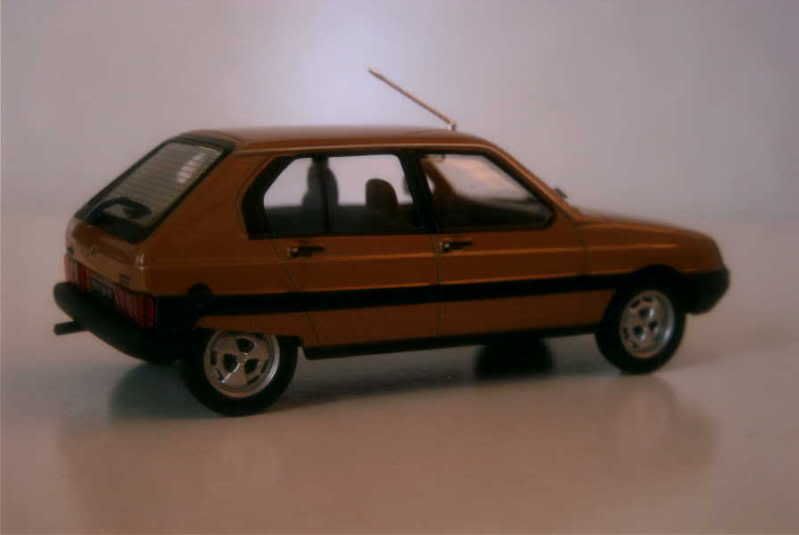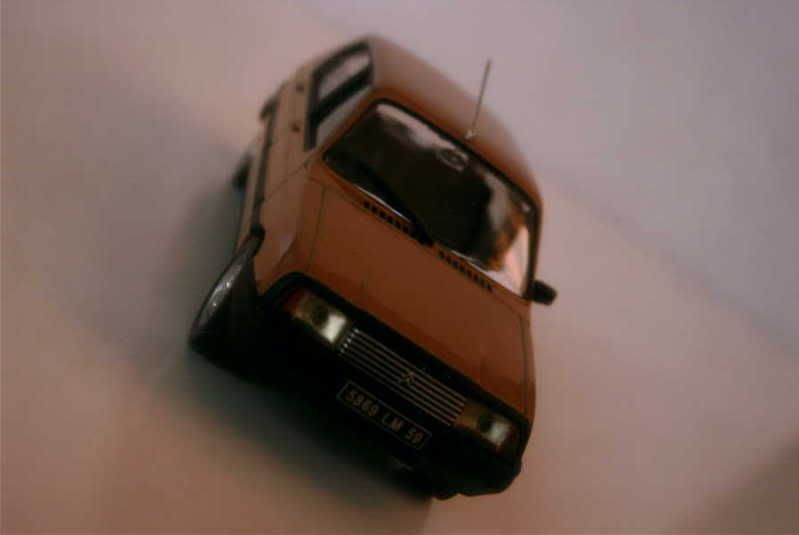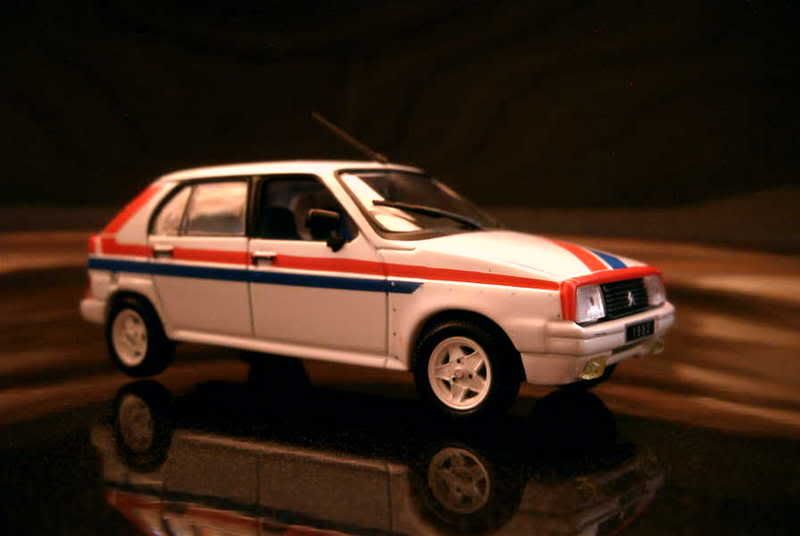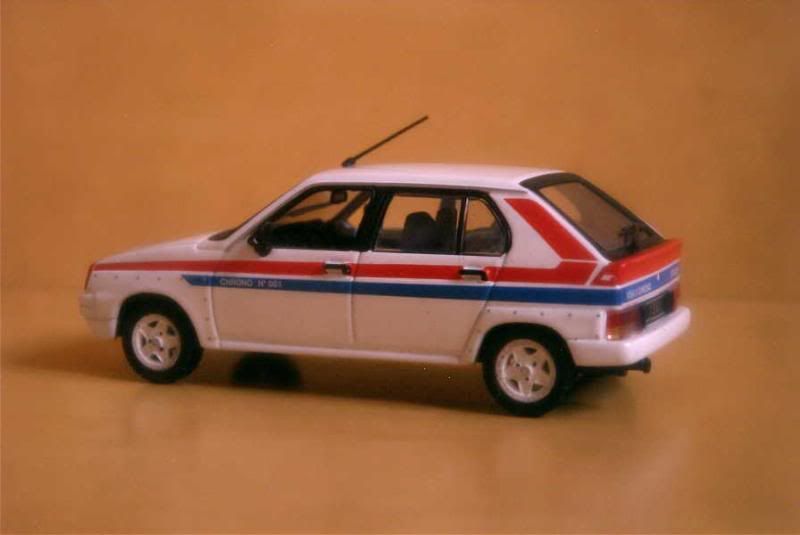A little history
The Visa was the first totally new car launched by Citroën after the company had been taken over by Peugeot in 1974. Though some aficionados of the double chevron found it unworthy to bear their favourite nameplate, the Visa was very much a Citroën. Though based on the Peugeot 104 saloon’s platform, it had unmistakeable Citroën styling with rear wheel arches similar to those of the GS or CX, the traditional flat-twin, and the long-travel independent suspension that made the ride in a 2CV so typical. Nonetheless the upper Visa, called the Super, received a water-cooled inline four displacing 1.1 litre, that the 104 lent to its sister-in-law – this version attracted much of the critics for being “too much Peugeot”.
The main downside of the Visa was perhaps its controversial styling. Extensive use of plastic and a convoluted front end were pointed at. On the other hand economy, spaciousness, comfort, handling were often cited among its qualities. Only on the long term should a tendency to rust and difficult maintenance be discovered.
Launched in October 1978 during the Paris motor show, the Visa was intended as a badly needed replacement for the Ami, then seventeen-year old. In fact, it also seriously overshadowed the Dyane. Supposedly the 2CV’s successor, the Dyane did not resist this competition and retired in 1983.
In March 1981, Citroën addressed some of the remarks regarding its car’s styling by introducing a Visa II – the numeral intended to mark the break with the first series. It was essentially a facelift conducted by Heuliez. The coachbuilder simplified the complicated grille, which not only attracted critics but also dirt, and added some plastic mouldings intended to make this narrow, tall car appear wider. The very same Heuliez would also develop a four-door convertible version, a rather rare body type since the end of World War Two, which was sold from 1984. Indeed, the Visa range started to extend exponentially during those years, even if the car was slowly approaching its retirement. Its main developments included a diesel version powered by the well-born BX engine, noted for a time as one of the most economical automobiles in the world; sporty versions including the GT (1.4-litre, 80 hp), the Chrono (1.4-litre, 93 hp), the GTi (1.6-litre, 105 then 115 hp), and the Mille Pistes (1.6-litre, 112 hp, four-wheel-drive). The latter was the homologation version of a nimble rally car Citroën had developed from its Visa. Despite its unlikely starting point, the Mille Pistes proved an efficient and affordable machine for many private entrants. Citroën also created a challenge opened to all female would-be-pilots, supporting the winning pair for the following season. Another derivative was a little van intended as a replacement for the Acadiane: the C15, introduced in 1984. It retained the front half of the Visa, but owed much to the BX, receiving its 1.7- then 1.9-litre diesel engines and its tough rear axle.
These many new additions to the range maintained some interest in the Visa, but it was nonetheless nearing the end of the road. In late 1986, the AX was unveiled. More pleasing visually, the new car had been designed to appeal to a wider number of motorists – but it also lost in the process both the originality and cleverness that were traditional Citroën qualities. A few Visa models were produced up to 1988. Was the Visa dead? Not completely, for the C15 van had encountered an incredible success. Economical, rugged and roomy, it offered excellent value for money. Citroën kept it in production until 1996, when the Berlingo was launched as its replacement. Was the Visa-based C15 dead then? Still not! Customers were still far too many to close its production line, which was moved to Citroën’s Spanish and Portuguese plants, where it was built until… December 2005! Received with scepticism in 1978, the Visa and its derivatives were actually built for more than twenty-seven years in 2.5 million copies.
A special mention should be made of the Oltcit. In 1976, Citroën signed a partnership with the Romanian government planning the construction of an automobile factory in Craiova. Plans were grandiose, forecasting 300,000 cars of various models being built every year. Actually, the harsh conditions dictated by the Ceaucescu government, widespread corruption of local officials and abysmal construction quality condemned the only car ever built in Craiova, the Visa-based Oltcit. Lengthy delays meant production of this two-door variant of the French car didn’t start until 1984. Cars exported as the rebadged Citroën Axel, under the terms of the agreement, were basically rolling scrap. I seldom saw any when new, and these didn’t last long before being sent to junkyards, the natural habitat of this uncanny breed.
About the models
Model: Citroën Visa II Super E
Year: 1981
Maker: Ixo
Scale: 1/43
Distributed by: Altaya as no.88 of its Nos Chères Voitures d'Antan press series
Acquired: brand new, in October 2007, in Souillac, France
Just when you thought Ixo had improved the quality of the models it sold through Altaya's press series, came this model. Up front, nothing really bad – this die-cast is even nice. But from the rear, gosh… The ugly all-red lights just spoil the whole model. My advice for those who would purchase this car is to always try hiding its awful side when placing it onto your shelf... Furthermore wheels seem gigantic. My rating is 9/20, no more.



Model: Citroën Visa II Chrono
Year: 1982
Maker: Universal Hobbies
Scale: 1/43
Distributed by: Atlas as no.57 of its Passion Citroën press series
Acquired: new with neither box nor stand (probably a production overrun or quality control reject), in December 2006, in Hong Kong, S.A.R.
Too bad I was unable to acquire many of these models from Atlas’ press series. Provided by Norev or Universal Hobbies, most of them look great, and this Visa Chrono is no exception. A little detail about the real car: it was produce in limited quantities (four hundred perhaps – I cannot remember for sure) which were individually numbered. The game back then, when you spotted one, was to check its number, painted on the left front door. I’ll give 13/20 to this model.


The Visa was the first totally new car launched by Citroën after the company had been taken over by Peugeot in 1974. Though some aficionados of the double chevron found it unworthy to bear their favourite nameplate, the Visa was very much a Citroën. Though based on the Peugeot 104 saloon’s platform, it had unmistakeable Citroën styling with rear wheel arches similar to those of the GS or CX, the traditional flat-twin, and the long-travel independent suspension that made the ride in a 2CV so typical. Nonetheless the upper Visa, called the Super, received a water-cooled inline four displacing 1.1 litre, that the 104 lent to its sister-in-law – this version attracted much of the critics for being “too much Peugeot”.
The main downside of the Visa was perhaps its controversial styling. Extensive use of plastic and a convoluted front end were pointed at. On the other hand economy, spaciousness, comfort, handling were often cited among its qualities. Only on the long term should a tendency to rust and difficult maintenance be discovered.
Launched in October 1978 during the Paris motor show, the Visa was intended as a badly needed replacement for the Ami, then seventeen-year old. In fact, it also seriously overshadowed the Dyane. Supposedly the 2CV’s successor, the Dyane did not resist this competition and retired in 1983.
In March 1981, Citroën addressed some of the remarks regarding its car’s styling by introducing a Visa II – the numeral intended to mark the break with the first series. It was essentially a facelift conducted by Heuliez. The coachbuilder simplified the complicated grille, which not only attracted critics but also dirt, and added some plastic mouldings intended to make this narrow, tall car appear wider. The very same Heuliez would also develop a four-door convertible version, a rather rare body type since the end of World War Two, which was sold from 1984. Indeed, the Visa range started to extend exponentially during those years, even if the car was slowly approaching its retirement. Its main developments included a diesel version powered by the well-born BX engine, noted for a time as one of the most economical automobiles in the world; sporty versions including the GT (1.4-litre, 80 hp), the Chrono (1.4-litre, 93 hp), the GTi (1.6-litre, 105 then 115 hp), and the Mille Pistes (1.6-litre, 112 hp, four-wheel-drive). The latter was the homologation version of a nimble rally car Citroën had developed from its Visa. Despite its unlikely starting point, the Mille Pistes proved an efficient and affordable machine for many private entrants. Citroën also created a challenge opened to all female would-be-pilots, supporting the winning pair for the following season. Another derivative was a little van intended as a replacement for the Acadiane: the C15, introduced in 1984. It retained the front half of the Visa, but owed much to the BX, receiving its 1.7- then 1.9-litre diesel engines and its tough rear axle.
These many new additions to the range maintained some interest in the Visa, but it was nonetheless nearing the end of the road. In late 1986, the AX was unveiled. More pleasing visually, the new car had been designed to appeal to a wider number of motorists – but it also lost in the process both the originality and cleverness that were traditional Citroën qualities. A few Visa models were produced up to 1988. Was the Visa dead? Not completely, for the C15 van had encountered an incredible success. Economical, rugged and roomy, it offered excellent value for money. Citroën kept it in production until 1996, when the Berlingo was launched as its replacement. Was the Visa-based C15 dead then? Still not! Customers were still far too many to close its production line, which was moved to Citroën’s Spanish and Portuguese plants, where it was built until… December 2005! Received with scepticism in 1978, the Visa and its derivatives were actually built for more than twenty-seven years in 2.5 million copies.
A special mention should be made of the Oltcit. In 1976, Citroën signed a partnership with the Romanian government planning the construction of an automobile factory in Craiova. Plans were grandiose, forecasting 300,000 cars of various models being built every year. Actually, the harsh conditions dictated by the Ceaucescu government, widespread corruption of local officials and abysmal construction quality condemned the only car ever built in Craiova, the Visa-based Oltcit. Lengthy delays meant production of this two-door variant of the French car didn’t start until 1984. Cars exported as the rebadged Citroën Axel, under the terms of the agreement, were basically rolling scrap. I seldom saw any when new, and these didn’t last long before being sent to junkyards, the natural habitat of this uncanny breed.
About the models
Model: Citroën Visa II Super E
Year: 1981
Maker: Ixo
Scale: 1/43
Distributed by: Altaya as no.88 of its Nos Chères Voitures d'Antan press series
Acquired: brand new, in October 2007, in Souillac, France
Just when you thought Ixo had improved the quality of the models it sold through Altaya's press series, came this model. Up front, nothing really bad – this die-cast is even nice. But from the rear, gosh… The ugly all-red lights just spoil the whole model. My advice for those who would purchase this car is to always try hiding its awful side when placing it onto your shelf... Furthermore wheels seem gigantic. My rating is 9/20, no more.



Model: Citroën Visa II Chrono
Year: 1982
Maker: Universal Hobbies
Scale: 1/43
Distributed by: Atlas as no.57 of its Passion Citroën press series
Acquired: new with neither box nor stand (probably a production overrun or quality control reject), in December 2006, in Hong Kong, S.A.R.
Too bad I was unable to acquire many of these models from Atlas’ press series. Provided by Norev or Universal Hobbies, most of them look great, and this Visa Chrono is no exception. A little detail about the real car: it was produce in limited quantities (four hundred perhaps – I cannot remember for sure) which were individually numbered. The game back then, when you spotted one, was to check its number, painted on the left front door. I’ll give 13/20 to this model.





No comments:
Post a Comment